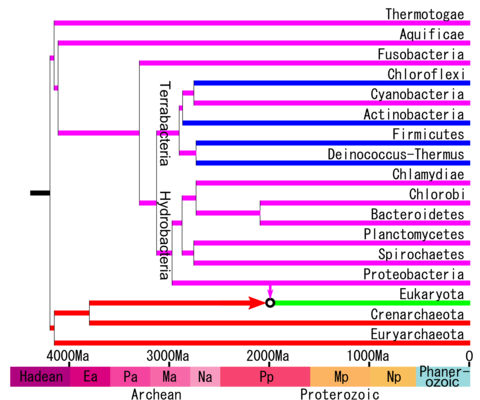Gracilicutes
| Gracilicutes | |
|---|---|

| |
| Escherichia coli cells magnified 25,000 times | |
| Scientific classification | |
| Domain: | Bacteria |
| (unranked): | Gracilicutes Gibbons and Murray 1978[1] |
| Superphyla/Phyla | |
|
Various definitions, see text | |
Gracilicutes (
Traditionally
- Gracilicutes (gram-negative, it is split in many groups, but some authors still use it in a narrower sense)
- Firmacutes [sic] (gram-positive, subsequently corrected to Firmicutes,[4] today it excludes the Actinomycetota)
- Mollicutes (gram variable, later renamed Tenericutes and now Mycoplasmatota, e.g. Mycoplasma)
- methanogens and classed as Archaea)
This classification system was abandoned in favour of the
Using hand-drawn schematics rather than standard molecular phylogenetic analysis, Gracilicutes was revived in 2006 by
A taxon called
Relationships
The phylogenetic tree according to the phylogenetic analyzes of Battistuzzi and Hedges (2009) is the following and with a molecular clock calibration.[9]

Recent phylogenetic analyzes have found that proteobacteria are a paraphyletic phylum that could encompass several recently discovered candidate phyla and other phyla such as
Phylogenetic analyzes have found roughly the following phylogeny between the major and some more closely related phyla.[12][13][14][15]
| Hydrobacteria |
| ||||||||||||||||||||||||||||||||||||||||||||||||||||||||||||||||||||||||
According to the phylogenetic analysis of Hug (2016), the relationships could be the following.[16]

The following graph shows
Cavalier-Smith's Tree of Life, 2006[cstol 1]
[A]
|
| ||||||||||||||||||||||||||||||||||||||||||||||||||||||||||||
Legend:
[A]
[B] Oxygenic Photosynthesis, Omp85 and four new catalases.
[C]
[D]
[E] Flagella.
[F] Four sections: an amino acid in HSP60 and FtsZ and a domain in RNA polymerases β and σ.
[G]
[H]
[I] Glycerol 1-P dehydrogenase.
[J] Proteasome and phosphatidylinositol.
[K] Neomura revolution: Replacement of peptidoglycan by glycoproteins and lipoproteins.
[L] Reverse
[M] Phagocytosis.
- PMID 16754610.
References
- ^ .
- PMID 18834516.
Accounting for horizontal gene transfers explains conflicting hypotheses regarding the position of Aquificales in the phylogeny of Bacteria
- ^ Krieg NR, Holt JC, eds. (1984). Bergey's Manual of Systematic Bacteriology. Vol. 1 (1st ed.). Baltimore: Williams and Wilkins.
- ^ Murray RG (1984). "The higher taxa, or, a place for everything...?". In Krieg NR, Holt JC (eds.). Bergey's Manual of Systematic Bacteriology. Vol. 1 (1st ed.). Baltimore: Williams and Wilkins. pp. 31–34.
- PMID 2439888.
- ISBN 978-0-387-24143-2. British Library no. GBA561951.
- ^ PMID 16834776.
- ISBN 978-0-387-95042-6. British Library no. GBA561951.
- ^ PMID 18988685.
- S2CID 233872903.
- PMID 35205421.
- PMID 27774985.
- S2CID 233872903.
- S2CID 4394530.
- PMID 31792218.
- S2CID 3833474.
